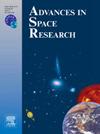Machine learning total electron content models based on F10.7
IF 2.8
3区 地球科学
Q2 ASTRONOMY & ASTROPHYSICS
引用次数: 0
Abstract
The ionospheric total electron content (TEC) is a crucial parameter to calculate the ionospheric corrections for global navigation satellite systems and other systems that utilize the ionospheric high frequency radio band. To date, a number of empirical models have been developed to estimate both current TEC and forecasted TEC. However, with the exception of operational models, for which input parameters are broadcast, users do not typically have access to such parameters for other models. We present a methodology that enables the generation of the global TEC maps with a minimal set of input parameters (and their histories) for different forecast horizons, obviating the need to evaluate input parameters for the forecast date. The methodology employs the F10.7 index as the primary control parameter for the models, with additional features based on date and time. Various machine learning models were constructed, including gradient boosting, neural networks with recurrent LSTM cells, fully connected neural networks, and linear regression models for forecast horizons of 1, 3, 7, 30, 60, and 180 days. The main idea of the research was to change the generally used approach when you have to forecast drivers for a model before ionosphere forecasting. Our difference is to use previous indexes for TEC forecast. So to forecast TEC maps, there is no need to have the F10.7 index value for a forecast date. The created machine learning models demonstrate high quality. For example a 1-day forecast TEC model based on fully connected neural network / neural network with LSTM cells / gradient boosting / linear regression exhibited a root mean square error (RMSE) of 6.61 / 6.80 / 7.05 / 10.55 TECU, mean absolute error (MAE) of 4.51 / 4.70 / 5.03 / 7.87 TECU, and mean absolute percentage error (MAPE) of 20.87 % / 21.99 % / 25.57 % / 46.93 %, respectively. GEMTEC, IRI-2016 and Klobuchar models (used as a reference) demonstrated a RMSE of 10.52 TECU, 11.08 TECU and 15 TECU, respectively.
基于F10.7的机器学习总电子含量模型
电离层总电子含量(TEC)是全球导航卫星系统和其他利用电离层高频无线电波段的系统计算电离层改正量的一个重要参数。迄今为止,已经开发了许多经验模型来估计当前的TEC和预测的TEC。然而,除了可操作模型(其输入参数是广播的)之外,用户通常无法访问其他模型的此类参数。我们提出了一种方法,可以用最小的输入参数(及其历史)为不同的预测范围生成全球TEC地图,从而避免了对预测日期的输入参数进行评估的需要。该方法采用F10.7指数作为模型的主要控制参数,并带有基于日期和时间的附加特征。构建了各种机器学习模型,包括梯度增强、循环LSTM细胞神经网络、全连接神经网络以及预测1、3、7、30、60和180天的线性回归模型。这项研究的主要思想是改变通常使用的方法,当你必须在电离层预测之前预测模型的驱动因素时。我们的不同之处在于使用以前的指标进行TEC预测。因此,要预测TEC地图,不需要有预测日期的F10.7指数值。所创建的机器学习模型显示出高质量。例如,基于全连接神经网络/ LSTM细胞神经网络/梯度增强/线性回归的1天预报TEC模型的均方根误差(RMSE)为6.61 / 6.80 / 7.05 / 10.55 TECU,平均绝对误差(MAE)为4.51 / 4.70 / 5.03 / 7.87 TECU,平均绝对百分比误差(MAPE)分别为20.87% / 21.99% / 25.57% / 46.93%。GEMTEC、ir -2016和Klobuchar模型(作为参考)分别显示RMSE为10.52 TECU、11.08 TECU和15 TECU。
本文章由计算机程序翻译,如有差异,请以英文原文为准。
求助全文
约1分钟内获得全文
求助全文
来源期刊

Advances in Space Research
地学天文-地球科学综合
CiteScore
5.20
自引率
11.50%
发文量
800
审稿时长
5.8 months
期刊介绍:
The COSPAR publication Advances in Space Research (ASR) is an open journal covering all areas of space research including: space studies of the Earth''s surface, meteorology, climate, the Earth-Moon system, planets and small bodies of the solar system, upper atmospheres, ionospheres and magnetospheres of the Earth and planets including reference atmospheres, space plasmas in the solar system, astrophysics from space, materials sciences in space, fundamental physics in space, space debris, space weather, Earth observations of space phenomena, etc.
NB: Please note that manuscripts related to life sciences as related to space are no more accepted for submission to Advances in Space Research. Such manuscripts should now be submitted to the new COSPAR Journal Life Sciences in Space Research (LSSR).
All submissions are reviewed by two scientists in the field. COSPAR is an interdisciplinary scientific organization concerned with the progress of space research on an international scale. Operating under the rules of ICSU, COSPAR ignores political considerations and considers all questions solely from the scientific viewpoint.
 求助内容:
求助内容: 应助结果提醒方式:
应助结果提醒方式:


